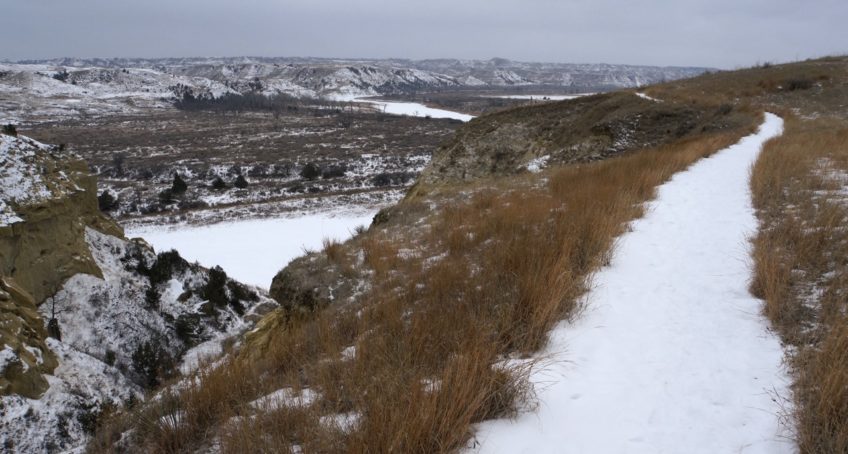After having extended my stay with family in the Twin Cities, I couldn’t help the feeling of excitement that crept over me as I readied my car for the drive west. Sure, it was -20° as I was loading my car and just about every fluid I could find was frozen solid, but it couldn’t put a damper on my spirit. One of the reasons for my excitement was my next book on tape: Zen and the Art of Motorcycle Maintenance. This is a book I had hoped to read years ago, but had never figured it into my schedule. Now, I was starting the book just as Robert Pirsig’s narrative begins: embarking on a road trip west from the Twin Cities. It doesn’t get much more perfect than that.
As I headed northwest towards Fargo, I couldn’t help but cower at the overwhelmingly bleak landscape that spread out before me. The dull grey of the low hanging clouds matched the windswept, snow spattered plains below, creating a cold, all-encompassing vista. Near the beginning, my route curved around stunted hills and the countless Minnesotan lakes, then the road straightened towards a flat horizon. I had reached North Dakota. With temperatures well below zero, gusts of wind shaped the landscape of dry snow, piling it here and uprooting it there. Alongside the highway, rows of trees stood guard against those winds, their purpose largely forgotten outside the growing season. Their leafless, skeletal shapes still cast scraggly shadows, but did little to break the constant wind.

Passing through Fargo, I was instantly reminded of the accent-infused, Cohen brother’s film of the same name. I had always thought that I had understood the chill that those characters experienced in that film because I had grown up in Wisconsin. Having to navigate a broken credit card reader on a gas pump as icy winds obliterated the dexterity of my fingertips turned out to be a quick reminder of how quickly we succumb to these temperatures. Relinquishing the idea of going for a run in this chill, I committed to a regimen of air squats at every stop for gas, anything to keep the blood pumping.

With Pirsig’s ruminations on “the Church of Reason” encouraging a dizzying analysis of my own thought processes and notions of conventional wisdom, I continued westward towards Bismarck. When I arrived, the winds and cold had slightly abated, but snowflakes had begun to drift aimlessly through the darkening sky. The combination of the open road, a good book on tape, and my paper maps had already made me feel like I was back in my travel groove. The feeling truly set in when I pulled into a parking spot at the Bismarck Wal-Mart for an overnight stay. I couldn’t help but feel excited about trying out some of the winter gear I had picked up for my first chilly night of winter car camping. On the first half of my trip, I had been forced to triple up on sleeping bags and liners, while wearing tons of layers, to cope with the icy temperatures in the higher elevations of the Rockies. Now I had my -30° Mountain Hardwear winter bag, which symbolized a snuggly night of warmth regardless of the howling winds and frigid temperatures. With my blackout panels, curtains, and pillows in place, I stripped off my layers and dove into the warm depths of my sleeping bag.


The next day, I slept in a bit before pointing Sam westward once more. My first stop was Theodore Roosevelt National Park. Established in 1978, this section of the North Dakota badlands commemorates and protects the lands that Theodore Roosevelt once called home. This eroded landscape of brilliant hues of red and orange, punctuated by the epic green of the grasslands was where Roosevelt came to reconnect with the land. Here, he worked the Maltese Cross Ranch, hunted, and rekindled his passion for living in close proximity to nature. After a promising military career, his political trajectory landed him in the White House. His presidency oversaw a prioritization and protection of natural resources. This desire to safeguard the wildness of natural spaces undoubtedly stemmed from his time in what would later become the National Park named after him. During his term as president, he set aside almost a quarter of a billion acres of protected land. He set a conservation precedent that we are still reaping the benefits of. If this land is partially responsible for his belief in wilderness, then it is surely a national treasure worth protecting.


My experience of Theodore Roosevelt National Park was somewhat different than the lush, colorful landscape that Roosevelt described. Winter had erased much of the color. Low clouds and shifting banks of snow painted the landscape in gray scale, obliterating the hues that hid underneath. The winds that shape this eroded landscape tore through the canyons and over the buttes, carrying hard snow with them. Despite its beauty, the park was particularly uninviting. With most of the roads in the park closed, I explored the available section of the Southern Unit before moving north along a gravel road through the Little Missouri National Grassland towards the North Unit.

There are two routes between the South and North Unit of Theodore Roosevelt National Park. My map showed a dotted line running north from the South Unit that avoided the main road for quite some time. When I asked the ranger what this road was like, she stated that it existed to serve the oil workers and ranchers in that region of the National Grassland. The gravel road turned out to be very well maintained and well traveled. It wound through country that easily could have been included in the National Park. The only difference was the ever-present oil wells with pumpjacks perpetually maintaining their slow, circular rhythm. As the road wound around buttes and skirted valleys, I started to notice pumpjacks, storage tanks, and gas flares around almost every corner. The inescapable irony of their presence was baffling. Here I was driving through federally protected grasslands that were brimming with industrial extraction. As the sun sank towards the horizon, the magnitude of the dichotomy became even more apparent. The dim gray of the day had hidden many of the gas flares, but the night showcased the flickering orange lights that dotted the surrounding hills and illuminated the low hanging clouds. They twinkled, almost like stars.




After weaving back and forth between the Central and Mountain Time zones, I finally made it to Williston, ND, where I had planned on bedding down for the night. Earlier that day, I had researched my options for the night. In general, the Wal-Marts and big business in North Dakota had seemed relatively open to the idea of overnight parking, but the Wal-Mart’s in Williston and Dickinson strictly forbade it. This wasn’t the first time I had run into this problem, but it was the first time that I decided to research why they had much such a decision. It seems that the past few years have seen a shortage of employment for oil workers, which is one of the main industries in the western part of North Dakota. That shortage had led to temporary communities of dozens of unemployed oil workers to congregate at the Wal-Marts in Dickinson and Williston. In order to deal with these relatively unsightly communities, both Wal-Marts had banned overnight parking, towed all offending parties, and put in place roaming security cars to enforce the rule moving forward. In search of a place to stay, I expanded my research to the town of Williston itself, finding that, as of January, 2016, the city had banned overnight parking in the city lots. Previously, a 48-hour parking rule had been in place. Clearly, this town was shutting down its support for vagrant populations.
Worried, I began expanding my search, until I decided to stay at a truck stop just out of town. I had always known I could utilize this resource, but I had never needed to take advantage of it. Pulling in, I noticed a group of sedans and trucks tucked at one side of the parking lot. I nestled in between a massive Ford truck and a Chevy mini-van, both of which were clearly occupied. After five-minutes of set up, I once again curled up in my sleeping bag, but sleep did not come as easily. The comings and goings of semi-trucks, constant din of engines running, and the freezing temperatures (-25°) proved less than ideal. After a little tossing and turning, I fell into a restless, but much needed sleep.
Routing for the Day



One Response
Mom
This post reminds me that Warren Nelson wrote a song about the Little Missouri River, and his daughter’s name is Medora. He must have had a special affinity for this landscape. Thanks for evoking it so well for us.